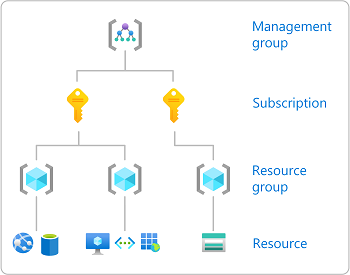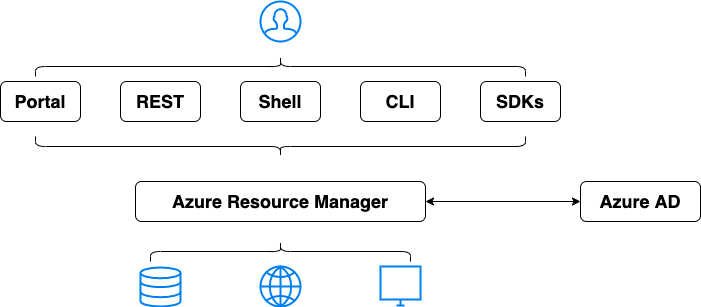Azure
Azure portal
http://portal.azure.com
AZ-900
0. Azure-900 Outline
- Study Areas
- Cloud Concepts, 15-20%
- Core Azure Services, 30-35%
- Security, Privacy, Compliance, and Trust, 25-30%
- Pricing, Service Level Agreement, and Lifecycle, 20-25%
1. Cloud Computing and Vocabulary
- Cloud Computing
- Storage, Computer Power, Networking, Analytics, etc. over internet
- Key Characteristics
- Scalability, size, amount
- Elasticity (automatically scaling), users, time
- Agility, the ability to react qucikly, the ability to allocate and deallocate resources quickly
- Fault Tolerance, the ability to remain up and runing during component and service failures
- Disaster Recovery, replication, the ability to recover from an event that has taken down the service
- High Availability, the ability to keep services running for extended periods of time with very little downtime
2. Principle of economies of scale
3. CapEx vs OpEx and their differences
- Capital Expenditure (CapEx)
- Own infrastructure
- Big initial investment
- Maintenance, support staff, power & networking, hardware failures
- Operational Expenditure (OpEx)
- Rent infrastructure
- No initial investment
- Maintenance, operations team
| CapEx | OpEx |
|---|
| Up front cost | Significant | None |
| Ongoing cost | Low | Based on usage |
| Tax duction | Over time | Same year |
| Early termination | No | Anytime |
| Maintenance | Significant | Low |
| Value over time | Lowers | No change |
4. Consumption-based Mode
- No upfront cost
- No wasted resources
- Pay for additional resources when needed
- Stop paying at any time
- Multiple pricing components per service
- Very granular usage measurement
5. IaaS vs PaaS vs SaaS cloud service models
- Layers
- Storage, Networking, Servers, Virtualization, Operating System, Middleware, Runtime, Applications and Data
- On-Premises
- Cloud provider manages nothing
- You manage infrastructure, platform, software
- Infrastructure-as-a-Service
- Storage, networking, servers, virtualization
- Cloud provider manages infrastructure
- You manage platform & software
- Use cases
- Migration of workloads
- Test & development
- Storage, backups and recovery
- Virtual machines
- Platform-as-a-Service
- Operating system, middleware, runtime
- Cloud provider manages infrastructure & platform
- You manage software
- Use cases
- Development framework
- Analytics & business intelligence
- SQL, App Service, Logic Apps, Function Apps
- Software-as-a-Service
- Applications, data
- Cloud provider manages infrastructure, platform & software
- You manage nothing
- Use cases
- Buying of-the-shell applications
- One Drive, Outlook, Skype
6. Public, Private & Hybrid cloud deployment models
- Public cloud
- Everything runs on cloud provider hardware
- No local hardware
- Some services share hardware with other customers
- Pros, no CapEx, high availability & agility, pay as you go pricing, no hardware maintenance, no deep technical skills required
- Cons, security & compliance, ownership, specific scenarios
- Private cloud
- Everything runs on your own datacenter
- Self-service should be provided
- Pros, can support any scenarios, control over security, can meet any security & compliance requirements
- Cons, inital CapEx, limited agility, IT skills &s; expertise are mandatory
- Hibrid cloud
- Combine public & private clouds
- Great flexibility
- Pros, great flexibility, run legacy apps in private cloud, utilize existing infrastructure, meet any security requirements
- Cons, can be more expensive, complicated to manage, IT skills & expertise are mandatory
7. Geographies, Regions & Availability Zones
- Data center
- Physical facility
- Hosting for group of networked servers
- Own power, cooling & networking infrastructure
- Regions and region pairs
- East US, West US
- Geographic area
- Datacenters connected with low-latency network
- Locations for services
- Some services are only available only in certain regions
- Some services are global services
- Government regions, US DoD Central, US Gov Virginia, etc.
- Partnered regions, China East, China North
- Azure Speed Test 2.0
- Products available by region
- Region pair, > 300 miles
- Each region pairs with another region
- Region pairs are static and cannot be chosen
- Some services have platform-provided replication
- Planned updates across the pairs
- Data residency maintained for disaster recovery
- East US - West US, UK West - UK South, North Europe - West Europe, East Asia - Southeast Asia
- Geographies
- Contain two or more regions
- Data residency, sovereignty, resiliency, and compliance requirements are met
- Fault tolerant
- Availibity zones

- Groups of physically separate facilities
- Designed to protect from data center failures
- Two service categories
- Zone services, virtual machines, disks, etc.
- Zone-redundant services, SQL, storage, etc.
- Supported region has three or more zones, each zone has one or more data centers
- Core architectural components
8. Resources, Resource Groups & Resource Manager
- Resources
- Objects used to manage services in Azure
- Represent service lifecycle
- Saved as JSON definition
- Resource Groups
- Grouping of resources
- Hold logically related resources
- Organized by type, lifecycle, department, billing, location, or combination of these
- Resource groups are free
- An Azure resource must live in one and only one Resource Group
- Resource groups have their own location assigned
- Resources in the resource groups can reside in a different location
- Resources can be moved between resource groups
- az group create --name groupName --location eastus, create a resource group
- az storage account create --name storageAccountName --resource-group resourceGroupName --location eastus, create a resource in a resource group
- Resource Manager

- 1. Identify scope, management group, subscription, resource group, resource
- 2. Add a role from Access Control (IAM)
- 3. Select a role
- 4. Select who needs access, user, group, or service principal (applications)

- Management layer for all resources and resource groups
- Contrl access and resources
- Resource Explorer
9. Compute Services | VMs, VM Scale Set, App Service, Functions, ACI, AKS
- Virtual Machines
- Ubuntu, Windows, Oracle, Image
- Infrastructure as a Service (IaaS)
- Supports marketplace and custom images
- Virtual Machine Scale Sets
- Container Registry (ACR), host images
- Container Instances (ACI), run containers
- a solution for any scenario that can operate in isolated containers, without orchestration
- doesn't yet support port mapping, need expose the app access port directly
- Kubernetes Service (AKS), run K8s server
- App Services
- Functions
Microsoft Certified: Azure Fundamentals
Reference


